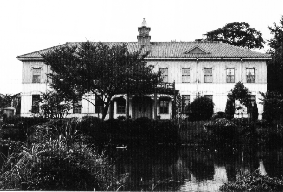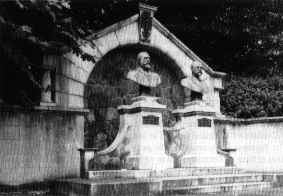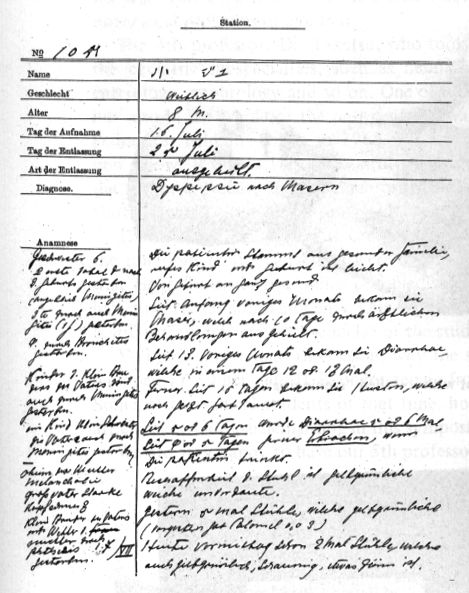
 Brief History of Our Department
Brief History of Our Department |
Fig.1: The oldest building of Tokyo Medical School(1874-). |
 |
Fig.2: Statues of Prof.J.Scriba,in the campus of the University. |

Fig.4: An eight-month-old girl with a acute diarrhea following measles
On behalf of the organizing committee, I would like to welcome all of you, and thank you very much for participating in this symposium. We are celebrating the 100th birthday of our department through this Symposium. I would like to take this opportunity to offer a brief history of our department.
The origin of the Faculty of Medicine of the University of Tokyo dates back to 1858, when a vaccination clinic opened at Kanda Otamagaike. In 1871, Tokyo Medical School, the predecessor of the Faculty of Medicine of our University, was created. Figure 1 shows the oldest building of that time, which remained intact even after the great Kanto earthquake and the Znd World War. It has been moved to the Koishikawa Botanical Garden at the University of Tokyo, where it is still in use.
The Japanese Government in the early Meiji Era decided to adopt the medical education systern of Germany, and in 1876 two German doctors, whose statues can be found across from the University Hospital, Dr. Elvin von Baelz and Dr. Scriba, (Figure 2), came to Japan and introduced modern medicine to the University of Tokyo. Dr. Baelz was a teacher of medicine, and probably was the first to lecture in pediatrics to the students at the University of Tokyo.
Å@In 1889, Doctor Tsukasa Hirota, one of the early graduates of the University of Tokyo, who had just re- turned from studying medicine in Strasbourg, was appointed the first, Professor of Pediatrics (Figure 3), and our department was founded. He was actually the father of pediatrics in Japan, and almost all of the professors of pediatrics in the other medical schools at that time were educated and trained by Prof. Hirota.
Figure 4 shows one of the oldest medical records of a patient, describing acute diarrhea following measles. Note that the whole description was written in German. Figure 5 is a 12-year-old boy, who was dmitted in 1912. Can anybody diagnose this case? This is Hirschsprung disease, congenital megacolon. A Danish pediatrician, Hirschsprung, first described this disease in 1888. Such an advanced case is never seen nowadays.
Å@One of the most important research works done and first described by Prof. Hirota and his associates was on iiso-called meningitis." The disease was exclusive- ly seen in breast fed infants, and if the breast feeding was stopped, meningitis eventually disappeared. This was later found to be a kind of lead poisoning by Dr. Koutaro Mrai, Professor of Pediatrics at Kyoto University, who was also a graduate of the University of Tokyo. Face powder at that time contained a high concentration of lead. This resulted in the contamination of mothers milk, and the discovery of lead meningitis. This is the patient , and crystals of lead were isolated from the cerebrospinal fluid of the patient as well as in the breast milk of the mother .
Dr. Hirota published the first textbook of pediatrics in Japan, and also initiated the first pediatric journal in Japan, in 1895. He founded the Japan Society of Pediatrics in 1897, together with Prof. Hirai of Kyoto University and Prof. Itoh of Kyushu University. Dr& Hirota served as professor for 31 years, and retired in 1921.
Ms successor was Dr. Shigenobu Kuriyama, who was born in 1889, exactly 100 years ago. Dr. Kuriyama was trained in the United States, and in spite of many difficulties during the 2nd World War, he himself trained many professors of pediatrics in Japan.
The 3rd professor, Dr. Takuma, endeavoured to rebuild the department after the war. Our department became a leader in the research of infectious diseases and nutritional problems of children.
The 4th professor, Dr. Takatsu, who took the chair in 1954, tried to establish the pediatric subspecialties, such as neonatology, neurology, cardiology, gastro- enterology, nephrology and so on. One of the biggest events, not only in his period but also in the whole of the past century, was the llth International Congress of Pediatrics, held in Tokyo in 1965 under his presidency . As most of you know, it was a very successful meeting. However, after the Congress came the fire of university unrest which originated from the Faculty of Medicine of the University of Tokyo, and extended all over Japan.
The main buildings of this campus were all occupied by radicad students, and the functions of the University were totally lost . It is still remembered that eight thousand riot police occupied the atNetic field next to this conference hall, to exclude radical students. Our department as well as the University of Tokyo is still suffering from some sequelae of the student unrest.
You may understand the reason, why the symbol of our university is presently wrapped in a blue net. It is under repair from the damage of twenty years ago. Some of the radical students of that time, however, have now become good pedi- atricians, and are participanting in this symposium.
We are very happy to have our Sth professor, Dr. Noboru Kobayashi with us. He succeeded Prof. Takatsu right after the university unrest in 1973. He was first trained in Cincinnati, and then in London, Great Ormond Street. Dr. Kobayashi spent a great deal of time and effort to organize our department after the university unrest. He was elected president of the International Pediatric Association in 1980, and promoted the research in soft pediatrics and child care in Japan.
During the past century, nearly one thousand pediatricians have been trained in our department. Presently our young colleague pediatricians are studying very hard. A new hospital will soon be built . We are looking forward to and have many expectations for the next century.
This has been a very brief sketGh of the history of our department. 100 years ago, we had nothing, but today most of the infectious diseases and nutritional problems have been overcome, and child health in Japan is most improved. We can be proud of having the lowest infant mortality rate in the world.
What should be remembered is, how much we owe our progress in pediatrics and child health today to Western countries, particularly to Germany and other Eu- ropean countries, and also particularly after the war, to the United States and Canada. We have therefore organized this symposium, inviting distinguished guests of various specialties from those countries. We have also invited some young promising pediatricians from Asian countries. Needless to say it is our newer responsibility to help the medical and health care of children in these countries. We hope this symposium today and tomorrow will have a large impact on pediatrics in Japan.

